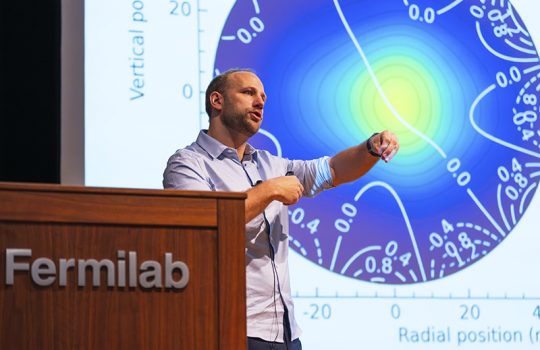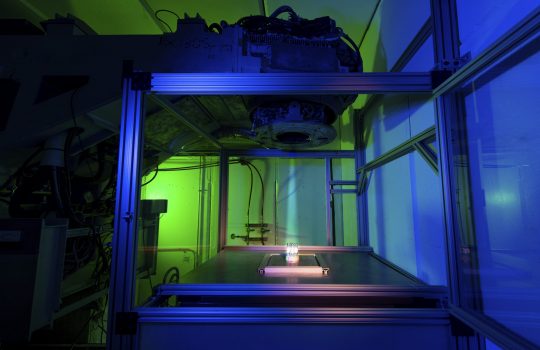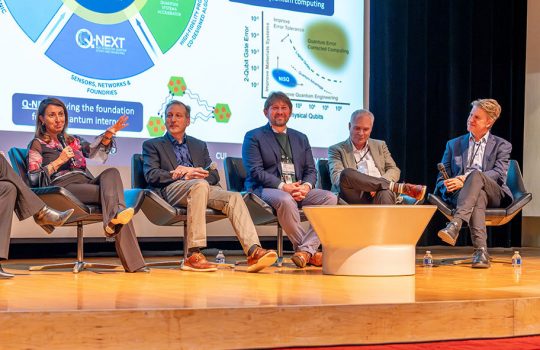Researchers at the U.S. Department of Energy’s Fermi National Accelerator Laboratory were recognized this April for their cutting-edge contributions to science and technology, earning six U.S. patents in 2024.
The annual Inventor Recognition Ceremony celebrated these achievements, spotlighting the transformative potential of Fermilab-developed innovations and the lab’s mission to connect its technological breakthroughs with private-sector partners — a key step in boosting U.S. economic competitiveness.
Cherri Schmidt, who recently retired as head of Fermilab’s Office of Partnerships and Technology Transfer, emphasized the real-world impact of these inventions.
“At Fermilab, ideas matter — not just in theory, but in impact,” Schmidt said. “When you develop a novel method, a piece of hardware, a unique process — you are not just solving a problem. You’re contributing to the advancement of science, to the national interest, and sometimes, even to industries and technologies that haven’t imagined your solution.”

Backed by world-class facilities and deep scientific expertise, Fermilab researchers developed several breakthrough technologies now protected by patents. The honorees and their patented innovations include:
Anna Grassellino, Sam Posen and Alexander Romanenko
- Methods and Systems for Treatment of Superconducting Materials to Improve Low Field Performance: Grassellino, Posen and Romanenko patented a method improving superconducting radio frequency cavities. This enhances performance by removing a thin layer that naturally forms on the inner surface of SRF cavities. The result is a dramatic improvement in the cavities’ quality factor that enables longer times for quantum states, demonstrating that SRF cavities are well suited for quantum computing, quantum memory, and next-generation accelerator technologies.
Robert Kephart and Aaron Sauers
- Beam Bending Snout for Mobile Electron Accelerators: Kephart’s and Sauers’ invention enables precise, on-site surface treatments and fabrication using mobile electron beams. Their work opens new possibilities for infrastructure repair, roadway strengthening and large-scale additive manufacturing.
- Infrastructure-Scale Additive Manufacturing Using Mobile Electron Accelerators: Kephart’s and Sauers’ additional patent uses the technology in the first patent to enable large-scale additive manufacturing with electron-beam accelerators. Its applications include on-site fabrication or repair of infrastructure like roads by cross-linking polymers, bitumen or other materials, all while the accelerator is mounted on a mobile platform like a truck.
Vadim Kashikhin
- Conductor on Molded Barrel Magnet Assembly and Associated Systems and Methods: Kashikhin’s COMB magnet design uses advanced 3D printing to create a custom support structure that precisely holds superconducting cables in place, reducing stress on the materials and simplifying construction — all of which are essential for building the next generation of accelerators or upgrading existing ones. Kashikhin’s design will make cutting-edge particle physics experiments stronger and more efficient.
Vladimir Kashikhin
- High-Temperature Superconducting Magnet: Kashikhin’s design creates highly stable magnetic fields without the need to keep a magnet constantly powered. The design uses a special type of coil made from stacked high-temperature superconducting tapes. This marks a significant advancement, producing magnets with long-lasting magnetic fields essential for particle accelerators and magnetic levitation systems like maglev trains.
Roger Milholland
- Portable Self-Contained Pressure Testing Manifold and Associated Methods: With flexible hoses, multiple pressure gauges, safety valves and clearly marked controls, Milholland’s design enables technicians to gradually test pressure, check for leaks and easily switch between air or water as the testing medium. The setup simplifies compliance with American Society of Mechanical Engineers standards while keeping everything organized in a sturdy case and ready to go for use in the lab or in the field.
Prasanth Shayamsundar
- Non-Boolean Quantum Amplitude Amplification and Quantum Mean Estimation Systems and Methods: Shayamsundar developed a quantum algorithm that radically speeds up certain types of computations, completing tasks in minutes with the help of quantum computers that, by contrast, would take years for a traditional computer to complete. It can help scientists spot patterns — subtle deviations or meaningful averages — within the complexity of the system they’re studying.
“These patents are a testament to the creativity and dedication of our scientists and engineers,” said Fermilab interim director Young-Kee Kim. “They reflect the laboratory’s commitment to advancing discovery while delivering technologies that make a positive difference in the world.”
Fermi National Accelerator Laboratory is America’s premier national laboratory for particle physics and accelerator research. Fermi Forward Discovery Group manages Fermilab for the U.S. Department of Energy Office of Science. Visit Fermilab’s website at www.fnal.gov and follow us on social media.



